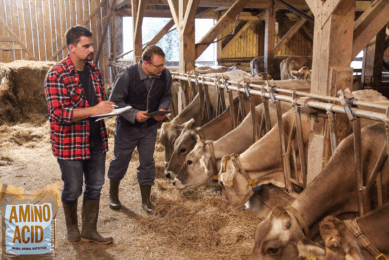Do we still need to work with crude protein?

The term crude protein is still often used in diet formulation. But some may question whether this is still up to date. After all, it is all about the amino acids, not crude protein content.
The definition of crude protein, which quantifies as the amount of analysed nitrogen multiplied by a factor of 6.25, goes back to the 19th century. In the 1860s, Henneberg and Stohmann attempted to break down feed composition into various groups of substances for analytical purposes. Crude protein was defined by the nitrogen-containing fraction, whereby the average nitrogen content was assumed to be 16% (resulting in a factor of 6.25). These groups of crude nutrients, which include water, crude protein, crude lipid, crude fiber, nitrogen-free extracts (NFEs), and ash, all add up to 100%.
While the Weende Analysis, as this method is called, has been modified, particularly with respect to greater differentiation within the carbohydrate fraction (see for instance van Soest et al., 1991), the N fraction continues to be used as a measure of crude protein to this day. The amount of crude protein that an animal consumes, in other words, is considered an indication of its nutrient intake. Nutritionists have to deal with crude protein on a regular basis. Sometimes, certain countries even require a minimum of crude protein in the animal feed formulation. Also certain labeling regulations for feed blends require that it must be indicated as a mandatory analytical parameter. But does this view on crude protein still make sense today?
Different nitrogen-containing components
Firstly, we need to point out that amino acids, which actually make up protein, are not the only nitrogen-containing components of the feed. Others include nucleic acids and nucleotides, which come from our genetic material in the form of DNA and RNA and which are present in all plant and animal cells. This fraction alone accounts for some 20% of what is known as non-protein nitrogen (NPN). Vitamins, amines, amides, urea, and other substances play a role here as well. The NPN fraction makes up some 10% of crude protein.
A misleading term?
Originally, an amino acid profile was assumed leading to the factor of 6.25 (16% N); a factor that is in fact variable, of course, and that depends on the amino acid profile and on the size of the NPN fraction. In the real world of animal nutrition, we rarely see feeds that correspond to a factor of 6.25, which merely represents a weighted average of the feed ingredients. We may conclude, as a result, that the term “crude protein” is rather misleading. In fact, the Weende Analysis does not involve analysing every crude nutrient: NFE is a calculated residual parameter, and if the N content of a protein deviates from the assumption of 16%, not only will the crude protein content contain an error but the calculated value for NFE and/or residual organic matter (van Soest method, etc.) will as well. If the estimated crude protein content is too high, the estimated NFE/residual organic matter content will automatically be too low. If for no other reason than this, we should dispense with the crude protein parameter, despite the fact that knowing the N content is important and even necessary.
Not indication of nutritional value
A far more important concern, however, is that crude protein does not provide any indication whatsoever of the nutritional value of a protein, making it utterly unsuitable for use as a nutrient. The nutritional value of a protein instead depends on the composition of the amino acids it contains. Monogastric animals (and humans), after all, require amino acids and not crude protein.
Figure 1 – Comparison between feed containing low levels of raw protein and a balanced amino acid profile.

Moreover, the quantitative and qualitative composition of amino acids must be considered in light of the requirements of the animal species, its stage of development, and its gender (and, in ideal case, other criteria). Studies on protein reduction and on amino acid dose responses offer striking confirmation of this correlation (Figure 1). Taking as the starting point a relatively unbalanced feed containing a great deal of crude protein, researchers achieved the same performance in broilers using a feed containing low levels of raw protein and a balanced amino acid profile (Figure 1). A deficit in one essential amino acid prevents protein synthesis from completing. Synthesis is instead interrupted, which leads to reduced growth performance (or, in the case of laying hens, reduced daily egg mass). Adding the missing amino acid to this feed has only a marginal effect on the crude protein content but an enormous impact on animal output and efficiency as demonstrated in Figure 2. In this example, the highest inclusion level of DL-Methionine (0.24%) contributed just 0.14% crude protein.
Figure 2 – Effect of adding the missing amino acid to crude protein content, animal output and efficiency.

Turn to essential amino acids
In other words, when lawmakers stipulate that compound feed for individual animal species shall contain a minimum level of crude protein, they are not in any way ensuring that the animals will obtain the amino acids they need in the quantities they need. In addition, requirements such as these prevent intelligent reductions in nitrogen content while maintaining an ideal amino acid composition. The latter not only has an enormous leveraging effect on N emissions in animal husbandry, it also impacts animal health. As a rule of thumb, lowering the N content in feeds by just one percentage point with the corresponding application of the ideal protein concept reduces N-excretions by 10%. It follows that we need to move away from the crude protein concept and would be better turning our attention to (essential) amino acids, a change that no longer poses any problem in analytical terms. Nutrition science journals and books could lead the way by reporting N content in conjunction with the amino acid composition rather than crude protein.
In terms of nutritional value, however, considering just the analysed amino acid content is still containing a source of error. It is sufficiently well known that animals cannot digest all individual ingredients of compound feed equally well, which means that different feeds vary in terms of overall digestibility (Table 1). In other words, feeds in which, say, the total methionine+cysteine content is identical may vary in terms of their nutritional value because one feed is more readily digested than the other, making more methionine+cysteine available to the animal. The challenge here, however, is that usually the content of digestible amino acids can be calculated but not directly analysed in a compound feed. Nevertheless, formulating feeds on the basis of digestible amino acids results in feeds that more precisely meet animals’ requirements. Requirements in terms of digestible amino acids are rather well known.
Analytical process
Another factor to consider has to do with the chemical analysis of amino acids and how those are indicated in certificates of analysis. The analytical process involves hydrolyzing proteins to break them down into their individual amino acids, which are then quantified and reported as complete, individual amino acids. Prior to analysis, however, vast majority of all amino acids are actually linked to each other via peptide bonds in proteins. This in fact means that one molecule of water (H2O) is missing for every amino acid in the protein, and that has implications for quantification. All of the amino acids in soybean meal extract (including tyrosine, and accounting for the difference both between glutamine and glutamic acid and between asparagine and aspartic acid) would add up to 46.3% (Table 2), for example. If corrected for H2O, however, that value is only 39.9%. It is easy to guess to which nutrient fraction the difference of six percentage points needs to be added to. That is to the analytical residual value (NfE, residual organic matter). Correcting for this lack of precision does not require analytical changes of any kind, as it can easily be derived mathematically.
Replacement of definition
In summary, crude protein is a meaningless parameter from the viewpoint of both nutritional physiology and the concept of precise livestock farming. The term is even misleading, because it contains quantitative errors that have implications in calculations for other nutrient fractions. In addition, crude protein does not reflect the quality of a protein (i.e., its amino acid content and digestibility), making data on crude protein content of little value. As such, we should avoid using the term crude protein, at best replacing it with information on nitrogen content along with a corresponding amino acid profile. Moreover, one should also consequently indicate amino acids in terms of digestible amino acids. One further point that could make animal feed evaluation and animal nutrition, respectively, more precise would be to correct the analytical amino acid content for the amount of water present, which, similar to crude protein content, results in substantial errors in calculated residual parameters (such as NFE, residual organic matter, etc.) when evaluating feeds.











